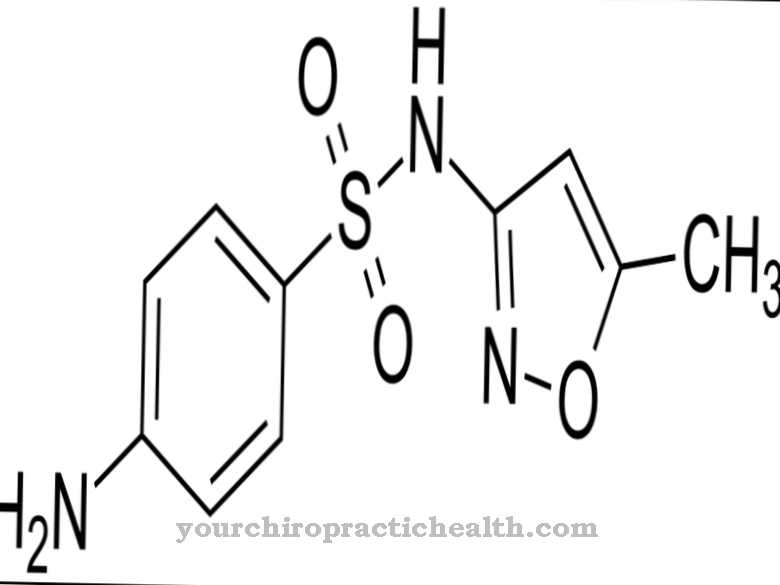Asenapine is an atypical neuroleptic and is one of the psychotropic drugs. Asenapine is used as a medicinal substance in psychoses such as bipolar disorder type I. The drug is manufactured in the USA. In Europe, asenapine, available in the form of sublingual tablets (to be placed under the tongue), has been marketed under the brand name Sycrest® since 2010. The drug requires a prescription and can only be given to adults.
What is asenapine?

Asenapine is a chemical, tetracyclic (four-ring) compound made from ozepane and benzene, pyrrolidine and chlorine. The medicinal substance was developed in the Netherlands, while processing into an antipsychotic takes place in the USA.
As a psychotropic drug, asenapine is one of the atypical neuroleptics. "Atypical" refers to the specificity of the side effects in contrast to comparable drugs.
In tablet form with pressed salt, the drug has been on the market in Europe under the name Sycrest® as a prescription drug for adults since the end of 2010. Sycrest® is prescribed for psychoses with pronounced manias such as bipolar I disorder. A Sycrest® sublingual tablet contains either 5 or 10 milligrams of asenapine.
Pharmacological effect
The exact mode of action of asenapine has not been clearly proven in pharmacological and medical research. Explanatory attempts by scientists are based on assumptions. According to scientific studies, what asenapine triggers where and why in the brain can be approximately understood.
It can be assumed that asenapine has an indirect rather than direct effect through an antagonistic effect (one substance cancels the effect of another): The chemical compound reverses other substances with a negative effect in the brain. Asenapine docks with certain receptors and influences them.
The action of messenger substances such as dopamine and serotonin can be guided in the desired path by signals from asenapine. For example, the neurological signal from restlessness to fatigue is reversed.
In order to have a high degree of effectiveness in the brain, the bioavailability (usability) of the medicinal substance must be maintained during transport through the body: When asenapine is taken orally (swallowed), less than 2 percent of the active substance reaches the brain as its destination. The bioavailability can be increased to 35 percent by direct absorption through the oral mucosa: The asenapine is transported faster and with less loss. Asenapine is therefore available as a sublingual tablet that can be placed under the tongue.
Medical application & use
Asenapine is prescribed as a neuroleptic primarily for bipolar I disorders (previously: manic-depressive illness) during moderate to severe phases of mania. Insomnia and restlessness are dampened by the administration of asenapine as well as strong irritability, over-activity as well as racing thoughts and distracted speech.
The medicine is to be taken in the morning and in the evening as prescribed by the doctor. Put the sublingual tablet straight from the packaging under the tongue with dry hands. The salt with the medicinal substance pressed into a tablet dissolves quickly in the oral mucus and quickly enters the bloodstream. After ingestion, the patient should not eat or drink for ten minutes to improve the effects.
Asenapine takes effect promptly and lastingly. According to studies, the first positive symptoms appear on the second day after ingestion and last for several weeks.
The prescription is approved for adults and excludes children and adolescents. For seniors over 65 years of age, dementia patients, pregnant women and breastfeeding women, doctors advise against taking it because of the uncertainty of effectiveness due to a lack of scientific studies.
You can find your medication here
➔ Medicines for painRisks & side effects
As an atypical neuroleptic, asenapine has different side effects than typical neuroleptics. Motor restlessness and twitching are rare side effects after taking asenapine.
An increased urge to eat with weight gain as well as tiredness and listlessness are very common. Anxiety and depression are other side effects. Dizziness, numbness in the mouth and impaired sense of taste may occur.
Weaker side effects include uncontrolled movements, as in Parkinson's disease, and an increased urge to move. Some patients complain of numbness in their arms and legs and stiff muscles. Laboratory tests show an increase in liver values caused by asenapine. It is not recommended for patients with severe liver dysfunction.



























